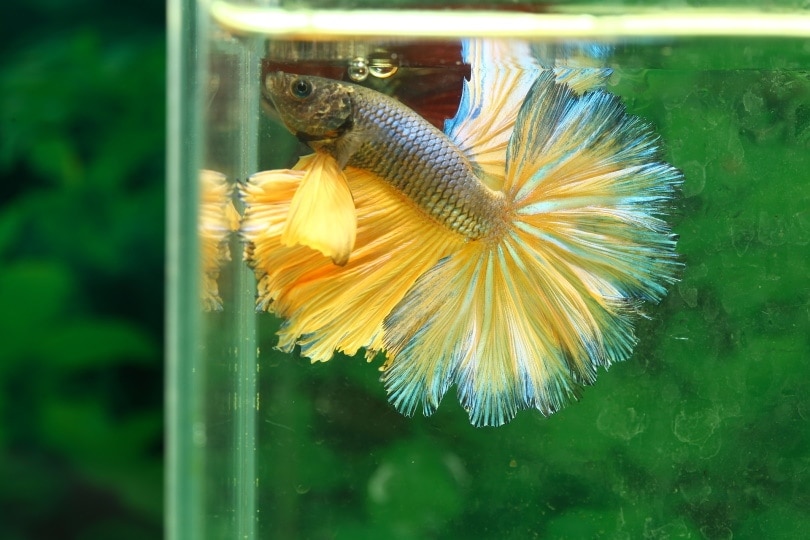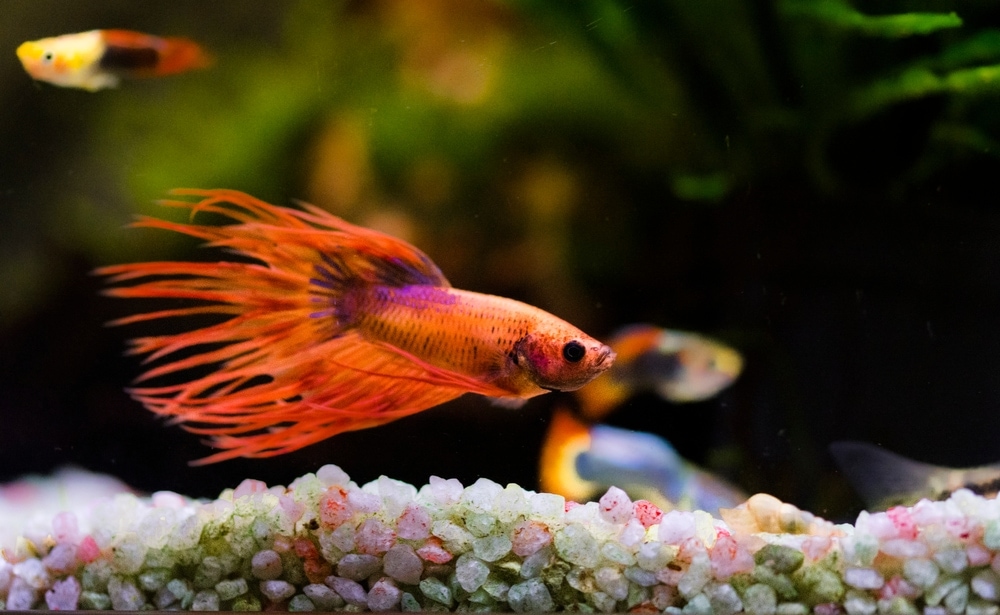Betta Tail Biting Guide: Causes, Signs, Treatment & Prevention Advice From Our Vet
By Dr. Luqman Javed, DVM (Vet)
Updated on

Click to Skip Ahead
Bettas are known for their gorgeous tails. The longer and more flowy the tail, the more that you can appreciate the grace and beauty of these fish. However, you might notice that your Betta’s tail looks ragged one day, and you might be alarmed to discover that your Betta is actually biting his own tail. What is going on here?
Let’s look at the physical signs that point to tail biting so you know for certain that it is the problem. Sometimes, tail rot can be mistaken for tail biting, and you’ll need to treat that differently. We also look at the causes of Betta tail biting and the best methods for treating and preventing it from occurring again.
What Is Tail Biting?
Tail biting is a behavioral disorder in Bettas. Like the name suggests, this disorder involves your Betta turning to bite their own tail off. The problem is most commonly seen in Betta variants with very long tails.
- Halfmoon & Over-Halfmoon
- Veil Tail
- Double Tail
- Delta & Super Delta
- Half Sun
- Rosetail
This disorder is often confused with two other fin conditions: fin rot and fin loss. Fin rot is not a behavior issue, but rather an infection (usually by a bacterium or fungus). Fin loss is somewhat similar to tail biting, and like the name suggests, it involves the loss of a Betta’s fins or tails. The difference is that fin loss can be attributed to bites inflicted by a bully or injuries sustained from sharp tank ornaments, whereas tail biting is a form of self-mutilation.
Bettas with short tails may also have this disorder. In these Bettas, this disorder is often not identified because their attempt to turn and bite at their own tail is often unsuccessful because their tail is just not long enough. It is sometimes mistaken for humor or whimsy by their owners. This problem is not reported in female Bettas, either because of their shorter fins or because they’re often housed in sorority houses where some degree of aggression is normal (therefore, it isn’t easy to tell why the tail is damaged).
What Causes Tail Biting?
There are several possible causes for tail biting, but there’s still a certain amount of mystery behind this disorder.
Stress
Stress is probably the number-one reason that Bettas start biting their tails.
- Not enough hiding places
- Overcrowding*
- Aquarium that is too small
- Bad or incorrect water conditions
- Illness
*Note: It is very difficult to distinguish between tail biting and fin loss in a community aquarium, unless you witness the act yourself.
Boredom
Boredom can overlap with stress. If your aquarium is too small or you don’t have enough decorations or items to entertain your male Betta, he could be bored.

Poor or Improper Nutrition
The lack of proper nutrition can have implications on the health of your Betta, and a poor diet is often linked to issues involving their fins and tail. Your Betta might resort to biting their tail if their diet isn’t adequate or if it’s improper for them.
Genes
It’s thought that some Bettas are more likely to bite their fins than others, as aggression can be inherited to an extent. Some Bettas are just more prone to it.
Long Fins & Tail
Some Bettas have large, long fins than others, and they might just start biting them out of frustration. The long fins might feel like they are slowing the Betta down, so he’s essentially trying to fix the problem.
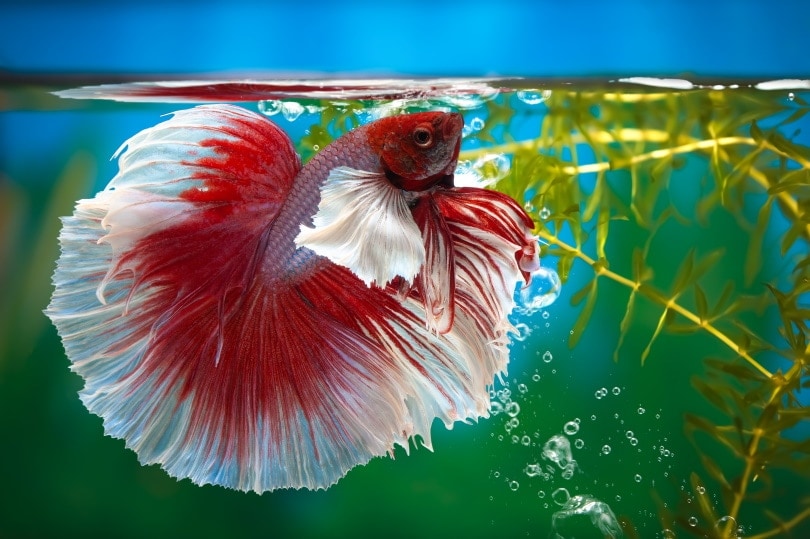
Signs of Tail Biting
You’ll know for sure that your Betta is tail-biting if you actually see him doing it. But otherwise, the following are the signs that tail biting might be occurring.
Rapid Loss
When pieces of your Betta’s tail start to go missing, you’ll notice that it will occur quickly and over a short period of time. The damage to his tail will seem to appear overnight or over just a few hours.
Clean Edges
The actual damage to the Betta’s tail will look “cleaner” than what you would typically see with fin rot. The edges of the damage are usually less ragged looking and have no discoloration.
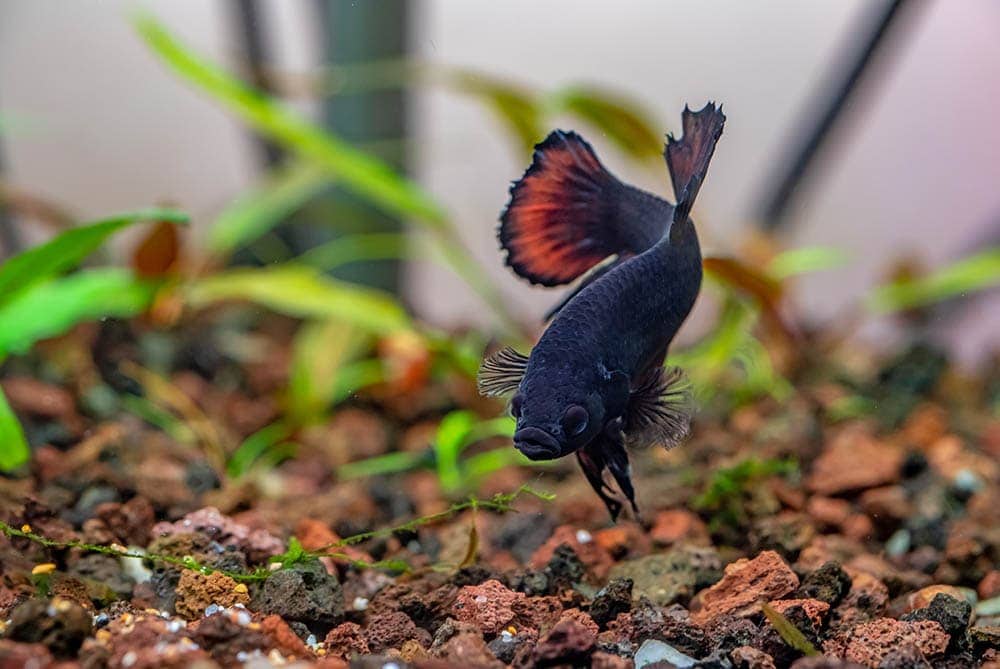
Missing Chunks
The pieces missing from your Betta’s tail are usually in round-looking chunks. There will be quite a few chunks missing in areas that your Betta can reach. If the missing pieces seem to be in areas that your Betta can’t reach, it’s probably a different issue.
Not Evenly Spread
When the problem is tail biting, the damage will appear to be in random spots rather than spreading out evenly along the edges of the fins and tail. Once you’ve determined that your Betta is indeed tail biting, you need to address it immediately before more damage is done. Knowing the cause will help with both treatment and prevention.
Treating Tail Biting
In a strict sense, there isn’t a standard treatment plan for tail biting, but rather tips and tricks you can use to try and curb the behavior. Therefore, while a treatment suggestion may work for one Betta, it may not work for another Betta (or yours). Unfortunately, tail biting is considered difficult to control in some cases, and it is advised that Bettas that obsessively bite their tail (almost out of compulsion) not be bred.
Here are some tips and tricks you can use to try and control this behavior:
Address Water Quality Issues
This is perhaps the best thing you can do if you observe your Betta biting their tail. Having a water testing kit at hand to check your water parameters is a great starting point. If your water parameters are not ideal for your Betta, the resulting stress may either perpetuate or exacerbate their tail biting behavior. Your Betta’s water test should reveal the following:
- Ammonia: 0 parts per million (ppm)
- Nitrite: 0 ppm
- Nitrates: Under 20 ppm
- Temperature: around 82-83°F (approximately 28°C)
Generally speaking, liquid test kits tend to be more accurate than paper test kits. If you find that your tests reveal values out of this range, you should perform a large water change (approximately 30-40% if parameters are incorrect) every other day until they are under control. You should also ensure you thoroughly treat any water you add into your Betta’s aquarium with a water conditioner. Water conditioners remove chlorine, chloramines, heavy metals, and other harmful substances from tap water.
With regards to pH, fortunately, Bettas are very tolerant to a very wide range of pH but prefer values near neutral (a value of 7.0).
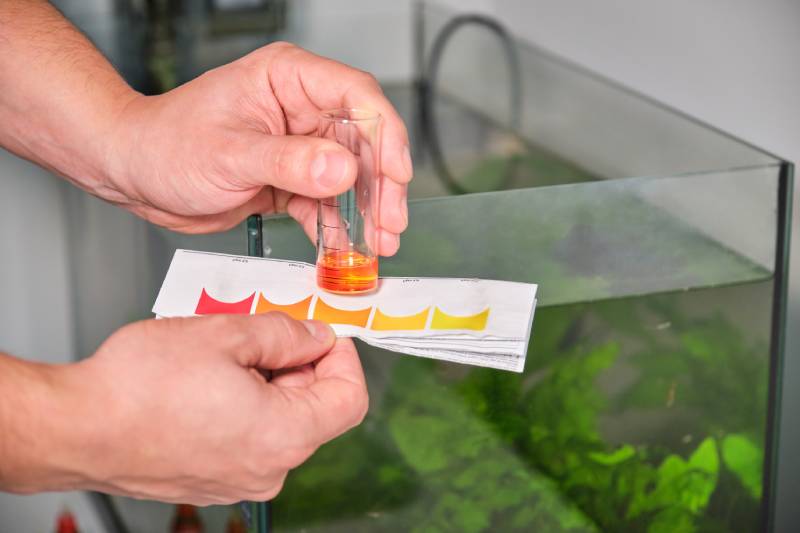
Rule Out Other Conditions or Diseases
Another part of controlling tail biting is making sure your Betta doesn’t have another issue which you might be misinterpreting as tail biting. Examples of such conditions or diseases include:
- Fin Rot: despite the name, this disease can affect a Betta’s tail too.
- Bullies: if your Betta is in a community setup, try isolating your Betta in a solitary aquarium to better assess your pet’s behavior.
- External Parasites: many external parasites, such as Velvet, Anchor Worms, or Ich may cause your Betta to aggressively rub on objects around the aquarium in an effort to dislodge the parasites. These may damage your Betta’s tail.
- Other Diseases: diseases such as columnaris may cause deterioration of the tail
It is best to consult with an aquatic veterinarian to better understand if your Betta is suffering from another disease or ailment.

Change of Scenery
If your Betta seems to be biting their tail out of boredom, it’s a good idea to change the decor in their aquarium, or to upgrade their aquarium size. The change of scenery might distract your Betta from their tail. Being naturally inquisitive, they may resort to exploring their new territory rather than engaging in biting their tail.
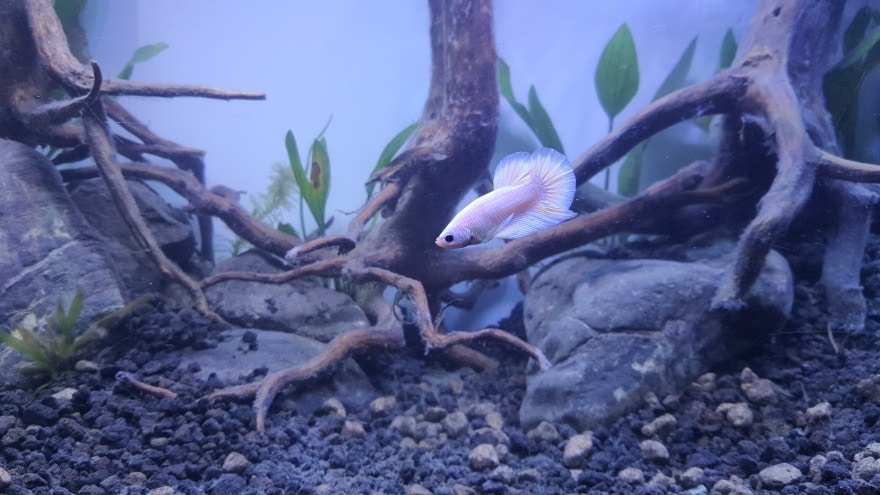
Address Diet & Incorporate Live Food
Ensure your Betta is eating a diet that is appropriate for them. At times, incorporating live food into their diet may also help. Your Betta may spend time chasing live food around their aquarium rather than biting their own tail. You can make this a challenge for your Betta by releasing live food in different parts of their aquarium, so they spend a good portion of their day finding and hunting their prey. However, you should make sure to not overfeed your Betta.

Stress Medication
Consider using a stress-reducing medicine in your tank if you suspect that your Betta is overly stressed. Many products are multi-purpose, and some stress supplements are also water conditioners.
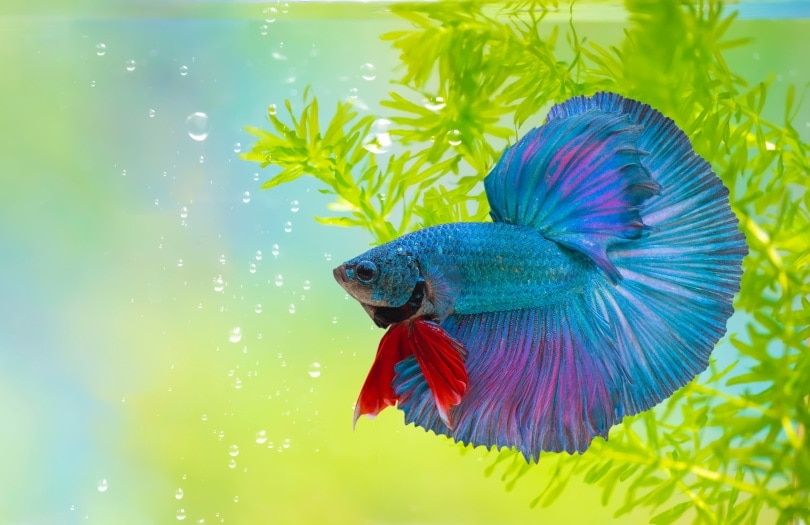
Preventing Betta Tail Biting
Because the causes of tail biting are still not completely understood, it’s very difficult to guarantee prevention of the condition. Generally speaking, all preventive measures involve ensuring your Betta is housed properly and that you stay on top of water quality checks and water changes.
- A single male Betta should be housed in a 5 gallon aquarium (as a minimum).
- The aquarium needs a filter and a heater. It is best to keep your tank at a temperature of around 82-83°F (approximately 28°C).
- A gentle sponge filter is the best for Bettas. They don’t appreciate strong currents.
- The aquarium should be placed in a room that’s slightly cooler than the setting on your aquarium heater. This ensures that your heater keeps the temperature stable for your Betta, but it also ensures that your Betta isn’t too warm (the heater won’t do anything if the ambient temperature exceeds its setting).
- You should perform a partial water change of at least 20-25% per week. Test your water on a weekly basis as well.
- Add decorations and plants that give your bettas some hiding spots. Live plants are preferred over artificial plants. However, if you are not sure how to care for live plants, artificial silk plants are an acceptable alternative. Ornaments and decorations you add to your aquarium should not have sharp edges or corners.
- Bettas appreciate plants with large leaves near the surface of the water, floating plants, or a fish hammock to rest on.
- Feed your Betta a good quality slow-sinking pellet made specifically for them. Supplement their diet with treats in the form of live, frozen, or freeze dried foods that are appropriate for them (such as brine shrimp or tubifex worms).
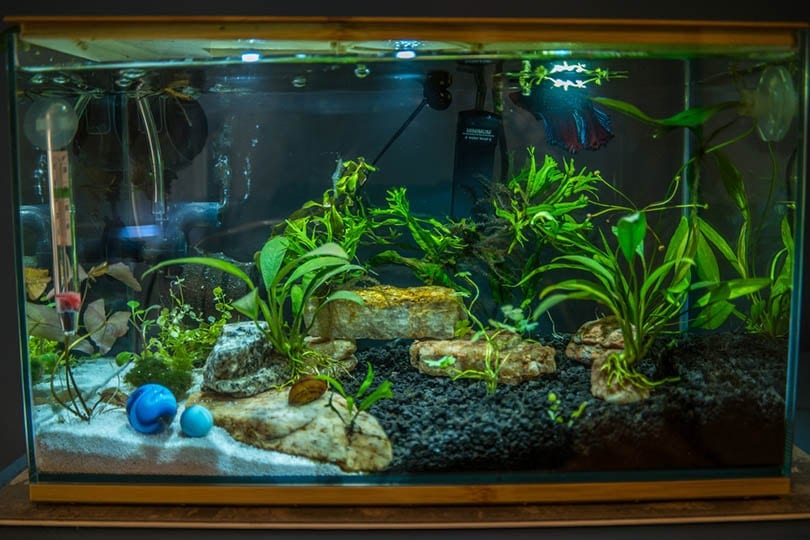
Final Thoughts
Tail biting is a rather frustrating behavioral disorder than some Bettas may be prone to. Though not completely understood as of yet, there are certain tips and tricks that you can try to curb this behavior. Proper care of your Betta goes a long way in ensuring that they are stress-free and healthy, which may prevent this behavior as well. If you’re in doubt about your Betta’s tail condition, or have other questions about their well-being, you should bring these concerns to your aquatic veterinarian.
Featured Image Credit: panpilai paipa, Shutterstock





